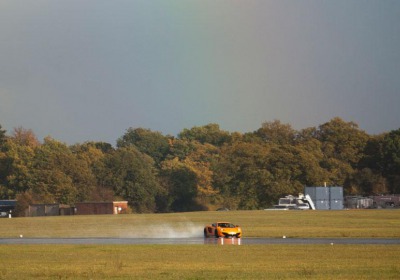Ultrasonic shields may replace wipers on future McLarens
Tue, 17 Dec 2013
A few weeks ago, the NHTSA issued a recall for all McLaren MP4 12-Cs originally sold or currently owned in Florida, Georgia, Alabama, Mississippi, Louisiana and Texas.
The reason? The combination of high heat and high humidity may cause wiper motor brushes to fail, something we imagine would be especially inopportune in the middle of a downpour. Just when you thought English engineers had figured out that whole on-board electronics thing ...
But McLaren may have hit upon a way to give the ghost of Lord Lucas the what-for for good, at least where windshield water removal is concerned. McLaren chief designer Frank Stephenson recently hinted that a piece of fighter jet-derived tech may make the jump to road cars, according to the Sunday Times. (Similar information is available, subscription-free, at The Daily Mail.)
The automaker is understandably tight-lipped about the specifics of the technology. But we know that it won't simply be fancy Rain-X. Supposedly, the system uses high-frequency sound waves, rather than a protective coating, to keep water and debris from contacting the glass. Presumably, some sort of ultrasonic generator could be attached to the glass of the windshield, which would then vibrate at the right frequency to keep the gunk away. It all sounds very sci-fi until you realize it's basically an electric toothbrush in reverse -- instead of using an ultrasonic brush to remove plaque, you use an ultrasonic windshield to prevent the road-plaque from adhering in the first place.
When you think about it, this sort of setup makes a lot of sense for fighter jets. Imagine wipers flapping away as you blast into the Danger Zone -- it would be silly even if it worked.
But there are a few reasons to go with a high-tech scheme like this on cars, as well. For one, a junebug will leave one hell of a splatter mark at track speeds -- better to simply prevent the goop from reaching glass in the first place. Then there's the possibility of improved aerodynamics, which has the potential to enhance performance and fuel economy. Seem trivial? Remember that automakers are also looking for ways to eliminate those pesky, obtrusive rear-view mirrors hanging off the side of your wind tunnel-sculpted car's body like a pair of drag chutes. Every little bit helps.
Most important, though -- especially for a low-volume, high-dollar manufacturer like McLaren -- is the novelty factor. Ultrasonic force fields practically market themselves, and the feature is a heck of a lot more useful (and a good measure less pretentious) than the set of gold-plated roadside repair tools McLaren tucked away in the F1. Provided that it actually works, we wouldn't be surprised if the technology made its way onto cars for the masses.
Can't say that about gold crescent wrenches.
By Graham Kozak

